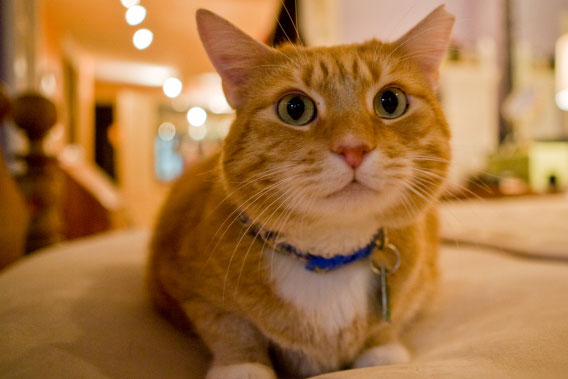Headed for Trouble
A veterinary cardiologist had a hunch about a possible risk factor for feline heart disease, and a Cummings student helped prove him right
By Catherine O’Neill Grace
It started as a hunch. Veterinary cardiologist John Rush noticed that many of his feline patients that had big heads also suffered from hypertrophic cardiomyopathy (HCM), a disease characterized by the thickening of the heart muscle.

Big-headed Hubert takes twice-daily doses of chicken-flavored beta-blockers to treat his hypertrophic cardiomyopathy, a common feline cardiac disease. Photo: Joanie Tobin
“Everybody made fun of Dr. Rush before when he made that comment,” recalls Vicky Yang, V09, who approached Rush about doing research with him. “And Dr. Rush said, ‘Let’s do something about it and prove it either right or wrong.’ ”
Working with Rush and Lisa M. Freeman, J86, V91, N96, both professors of clinical sciences at the Cummings School, Yang designed the research protocol, rounded up cats with HCM and a control group without the disease and set about trying to prove, or disprove, Rush’s theory.
It turned out that Rush was right.
The researchers examined 25 cats with HCM and 22 healthy control cats, using physical exams and echocardiography. They also collected data on dietary history, body weight, heart size and skeletal dimensions. They discovered that the cats with HCM had larger bodies than the healthy cats, and their skulls, vertebrae and long bones were significantly larger. Their findings were published in the August 2008 issue of the American Journal of Veterinary Research, with Yang as lead author.
“Our focus was trying to figure out if these cats grew faster when they were very young—really in the first year of life—and did that predispose them to HCM,” Yang says of the research, which was supported by the Barkley Fund and Boehringer Ingelheim Animal Health.
Hypertrophic cardiomyopathy afflicts 3 to 6 percent of all cats. It is a manageable, but not curable, condition that can be controlled with medications and diet. “But it’s a pretty serious disease and can reduce a cat’s lifespan,” says Freeman, who is board-certified in nutrition.
The disease also affects 1 in 500 humans, and is a leading cause of sudden cardiac death in young athletes. (New York Knick Cuttino Mobley ended his 11-year NBA career on December 11 after a diagnosis of HCM.) Multiple genetic mutations have been identified in people with HCM, and a genetic basis for the disease in cats is suspected. And while genes may predispose cats to developing HCM, the interplay between genetics and environmental factors such as diet and growth patterns may increase its severity.
“We have a lot of evidence from other species that changes in nutrient supply and growth rate in utero can have important effects in diabetes risk, the risk for heart disease and heart size in general,” Freeman says.
“We proved our observation,” says Yang, who plans to continue her cardiology studies after she graduates from the Cummings School next spring. “The next step is trying to find out how it happens. If we can prove definitely that it’s the early growth that impacts cats’ health, the finding could have significant implications.”
When Yang began to screen healthy cats for her study control group, she had trouble finding animals of a healthy weight. Of the 47 cats enrolled in the study, 70 percent were overweight or obese.
While that percentage may seem unusually high, Freeman notes there are plenty of fat cats in the United States. “The prevalence [of obesity] in cats mirrors the epidemic of overweight and obesity we have in people,” she says. “It’s a big, big problem, and could be related to why we’re seeing more heart disease in cats.”
The HCM study, in addition to uncovering potentially useful information about the disease, is a good example of the scientific method in action, Freeman says.
“We all have our ways we do things in practice, as well as observations we make,” she says. As a practicing clinician, Rush noticed that if a cat “had a big wide head, it’s very likely to have this heart disease,” Freeman says. “One of the really important things in veterinary medicine and medicine in general is to scientifically test those hypotheses.”
The researchers will continue to investigate genetic and developmental causes of heart disease in cats. “Our impression is that genetics is at the root of this disease, but nutrition has an important impact,” says Freeman.
This story first appeared in the Winter 2008 Tufts Veterinary Medicine magazine. Catherine O’Neill Grace can be reached at catherine.grace@tufts.edu.


